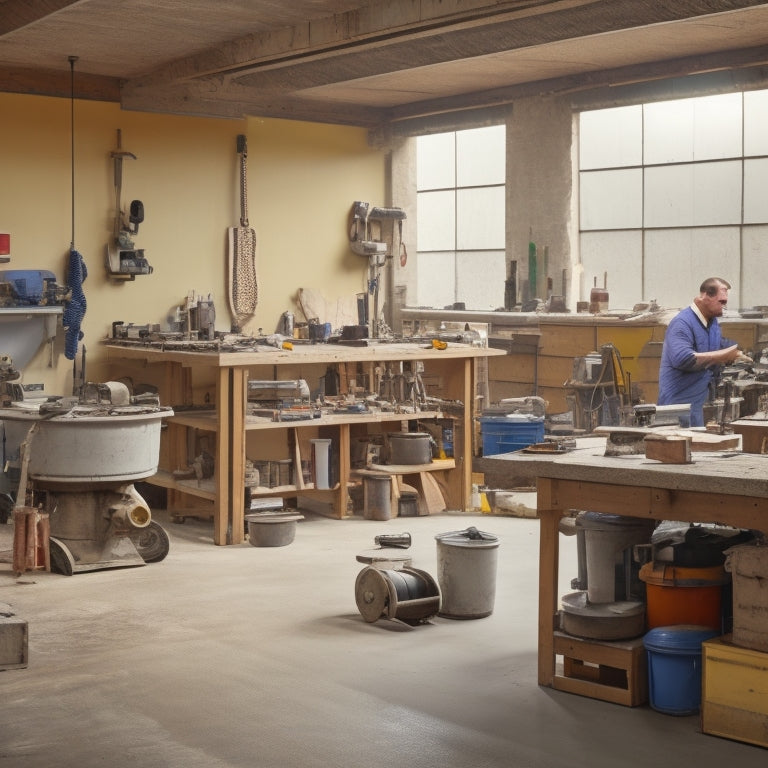
What Tools Do You Need for Concrete Sanding
Share
When tackling a concrete sanding project, you'll need a range of specialized tools to achieve a smooth, even finish. Start with abrasive sandpapers in various grits and types, along with dustless sanding equipment like orbital, belt, and rotary sanders. Handheld power sanders, floor sanders, and edger sanders will help you tackle different areas and spaces. Don't forget sanding blocks for flat surfaces, vacuum systems for efficient dust collection, and essential safety gear like goggles, masks, and protective clothing. With the right tools, you're ready to take on the challenge - now it's time to master the techniques that will bring your project to life.
Key Takeaways
• Sandpaper and abrasive tools, including open-coat, closed-coat, and semi-open coat sandpaper, are essential for concrete sanding tasks.
• Dustless sanding equipment, such as orbital, belt, and rotary sanders, minimize airborne particles and debris during concrete sanding.
• Efficient dust collection equipment, including HEPA filters and vacuum systems, is crucial for capturing dust generated during concrete sanding.
• Handheld and floor sanders, including drum and belt sanders, are necessary for smoothing and removing coatings from concrete surfaces.
• Edger sanders, sanding blocks, and safety gear, such as safety goggles and dust masks, are also required for effective concrete sanding.
Sandpaper and Abrasive Tools
You'll find that sandpaper and abrasive tools are the most common and essential tools for concrete sanding, as they effectively remove imperfections and smooth out the surface.
When selecting sandpaper, you'll encounter various types, including open-coat, closed-coat, and semi-open coat. Each type is suited for specific tasks, such as aggressive removal or fine finishing.
Abrasive grades, measured in grit, range from coarse (16-24) to fine (220-240). Coarser grits are ideal for removing old coatings or thick imperfections, while finer grits produce a high-gloss finish.
You'll also work with different abrasive materials, including aluminum oxide, silicon carbide, and ceramic. Aluminum oxide is a cost-effective option for general-purpose sanding, while silicon carbide is better suited for sanding metal or hard surfaces.
Ceramic abrasives offer superior durability and aggressive cutting action. Understanding the characteristics of each sandpaper type and abrasive grade will enable you to choose the right tool for your specific concrete sanding task, ensuring efficient and effective results.
Dustless Sanding Equipment Options
When you're sanding concrete, you know how critical it's to minimize dust and debris.
That's where dustless sanding equipment comes in - you'll want to choose the right type of dustless sander for your project, and guarantee it's equipped with an efficient dust collection system.
Dustless Sanders Types
Frequently, contractors and DIYers seeking to minimize airborne particles and mess opt for dustless sanders, which come in various types designed to suit specific concrete sanding applications and preferences.
You'll find that each type is engineered to cater to unique demands, from aggressive material removal to fine finishing.
For instance, orbital dustless sanders are ideal for general-purpose sanding, while belt dustless sanders excel in high-production environments. Meanwhile, rotary dustless sanders provide precise control for detailed work.
When choosing a dustless sander, consider factors like dustless technology, motor power, and sander maintenance requirements. Some dustless sanders feature advanced filtration systems, while others rely on vacuum attachments for dust collection.
You may also want to look for sanders with adjustable handles, ergonomic grips, and LED lights for improved visibility.
Efficient Dust Collection
To guarantee effective dustless sanding, it's essential to pair your dustless sander with efficient dust collection equipment, which can greatly reduce airborne particles and mess. This not only improves air quality but also enhances your overall sanding experience. When selecting dust collection equipment, consider the following factors:
| Feature | Benefits |
|---|---|
| High-Efficiency Particulate Air (HEPA) Filters | Captures 99.97% of particles as small as 0.3 microns, ensuring superior air quality |
| Dust Suppression Techniques | Reduces dust clouds and minimizes mess, making the sanding process more efficient |
| Air Quality Monitoring | Provides real-time monitoring of airborne particles, enabling you to adjust your dust collection strategy accordingly |
Handheld Power Sanders Needed
You'll require a handheld power sander capable of delivering high torque and speed to effectively remove imperfections and smooth out the concrete surface.
When selecting a handheld power sander, consider the following sander selection tips: choose a sander with adjustable speed control, a durable construction, and a comfortable grip to reduce fatigue. Additionally, guarantee the sander is compatible with various sanding pads and has a dust collection system to minimize mess.
Regular power tool maintenance is vital to extend the lifespan of your handheld power sander. Clean the sander regularly, check for worn-out parts, and replace them promptly.
Properly store the sander in a dry place, away from direct sunlight, to prevent damage. It's also essential to follow the manufacturer's instructions for maintenance and troubleshooting.
Floor Sanders for Large Areas
When you're faced with large areas of concrete to sand, you'll need to bring in the heavy artillery - floor sanders specifically designed for big jobs.
You'll have two main options: drum sanders and belt sanders, each with its own strengths and weaknesses.
Drum Sanders
Drum sanders, also known as floor sanders, efficiently tackle large areas by rapidly removing old coatings and smoothing out rough concrete surfaces.
You'll find various drum sander types on the market, each designed for specific tasks. For instance, walk-behind drum sanders are ideal for large, open spaces, while ride-on drum sanders are better suited for massive areas, such as warehouses or parking garages. When choosing a drum sander, consider the surface area you need to cover, the level of roughness, and the type of coating you're removing.
To guarantee peak performance and extend the lifespan of your drum sander, regular maintenance is vital. You should regularly inspect and replace worn-out sanding drums, as well as clean the machine's components to prevent dust buildup.
Additionally, keep the drum sander's wheels and bearings well-lubricated to reduce friction and prevent overheating. By performing these routine tasks, you'll be able to tackle even the largest concrete sanding projects with confidence and precision.
Belt Sanders
For large, open areas, belt sanders prove to be an efficient and effective tool, providing a high-performance solution for concrete sanding tasks.
You'll appreciate the ability to cover a lot of ground quickly, making them ideal for floor sanding applications.
Belt sander uses include smoothing out rough surfaces, removing old coatings, and preparing concrete for finishing. When choosing a belt sander, consider the size of the area you need to sand and the level of grit required for the task.
To guarantee peak performance, regular belt sander maintenance is essential.
You should regularly inspect and replace worn belts, as well as clean the machine to prevent dust buildup.
Additionally, make sure to follow the manufacturer's instructions for proper usage and maintenance. By doing so, you'll extend the life of your belt sander and achieve professional-grade results.
With the right belt sander and proper maintenance, you'll be able to tackle even the largest concrete sanding projects with ease and confidence.
Edger Sanders for Tight Spaces
Tackle tight spaces with ease using edger sanders, precision-designed to navigate corners, edges, and other confined areas that larger sanders can't reach. These specialized tools are engineered to fit into tight spaces, allowing you to sand areas that would otherwise be inaccessible.
When working with edger sanders, it's crucial to understand the key edger features that make them effective. Look for adjustable handles, vacuum ports, and dust collection systems to minimize mess and maximize control.
To master tight space techniques, practice using your edger sander at different angles and speeds. This will enable you to smoothly sand curved edges, corners, and other hard-to-reach areas.
Additionally, consider using specialized attachments, such as bent shafts or flex heads, to further increase your edger sander's versatility. By combining the right edger features with expert tight space techniques, you'll be able to achieve professional-grade results in even the most challenging areas.
With an edger sander in your toolkit, you'll be empowered to take on complex concrete sanding projects with confidence.
Concrete Sanding Pads Required
Equipping yourself with the right concrete sanding pads is essential, as they play a critical role in determining the quality of your sanding results. You'll need to choose the right pad for your specific concrete sanding techniques and the surface you're working on.
Here's a breakdown of common sanding pad materials and their uses:
| Material | Grit Range | Best For |
|---|---|---|
| Aluminum oxide | 16-120 | General-purpose sanding, removing minor imperfections |
| Silicon carbide | 16-220 | Aggressive sanding, removing old coatings, and preparing surfaces |
| Ceramic | 120-320 | Fine sanding, polishing, and honing concrete surfaces |
When selecting a sanding pad, consider the surface you're working on, the level of aggressiveness needed, and the desired finish. For example, if you're looking to remove old coatings or prepare a surface for new flooring, a silicon carbide pad might be the best choice. Remember to always follow the manufacturer's instructions and use the correct pad for your specific concrete sanding techniques to achieve ideal results.
Sanding Blocks for Flat Surfaces
When sanding flat surfaces, you'll often find that sanding blocks provide better control and more consistent results than sanding pads alone. These blocks are designed to keep the sanding pad flat and level, ensuring even contact with the concrete surface. This is particularly important for surface preparation, as uneven sanding can lead to imperfections and defects.
Using sanding blocks as part of your sanding techniques allows you to apply consistent pressure and maintain a steady pace. This results in a smoother finish and reduced risk of scratches or swirl marks. Additionally, sanding blocks can help you achieve a more uniform grit progression, which is critical for achieving the desired level of surface preparation.
When selecting a sanding block, look for one that's specifically designed for concrete sanding. These blocks typically feature a sturdy construction and a Velcro-type attachment system for securing the sanding pad.
Vacuum Systems for Dust Control
You'll markedly reduce the risk of airborne dust and improve overall job site safety by integrating a vacuum system into your concrete sanding process. This is especially essential when working with concrete, as the dust generated can be hazardous to your health and the environment. A reliable vacuum system will capture dust particles at the source, preventing them from spreading and settling on surrounding surfaces.
When selecting a vacuum system, look for one with vacuum attachments specifically designed for concrete sanding. These attachments are typically equipped with specialized nozzles and brushes that allow for efficient dust collection.
Additionally, confirm the system features a robust air filtration system, capable of capturing 99.97% of particles as small as 0.3 microns. This will guarantee that the air exhausted from the vacuum is clean and safe to breathe.
Safety Gear for Sanding Operations
Wearing the right safety gear is essential to protect yourself from the hazards associated with concrete sanding, including flying debris, dust, and airborne particles.
As you prepare for your sanding operation, don't overlook the importance of safety protocols to prevent injuries and guarantee a successful project.
Here are the essential safety gear you'll need:
-
Safety Goggles: Protect your eyes from flying debris and dust with ANSI-approved safety goggles.
-
Dust Mask: Prevent inhalation of airborne particles with a dust mask that filters out 99.97% of particles as small as 0.3 microns.
-
Protective Clothing: Wear long-sleeved shirts, long pants, and closed-toe shoes to prevent skin contact with concrete dust and debris.
- Hearing Protection: Use earplugs or earmuffs to protect your hearing from the loud noise generated by sanding equipment.
Frequently Asked Questions
Can I Use a Regular Vacuum for Dust Control While Sanding Concrete?
When it comes to dust control while sanding concrete, you'll want to opt for a vacuum specifically designed for dust collection.
A regular vacuum won't cut it, as it's not equipped to handle the heavy dust and debris generated by concrete sanding.
Look for a vacuum with a HEPA filter and a high CFM rating to guarantee effective dust collection.
You'll be able to work more efficiently and safely with the right tool for the job.
How Do I Prevent Scratches on Surrounding Surfaces During Sanding?
As you commence on the concrete sanding journey, you're maneuvering a delicate dance between precision and protection.
To prevent scratches on surrounding surfaces, you'll need to don your armor of caution. Apply masking film or tape to vulnerable areas, and use a dustless sanding system to contain the chaos.
Shield your surfaces with drop cloths or plastic sheets, and work methodically to guarantee a scratch-free zone.
What Is the Ideal Temperature for Sanding Concrete Surfaces?
When you're preparing to sand concrete surfaces, you'll want to guarantee the ideal temperature for best results.
Typically, temperatures between 60°F and 80°F (15°C to 27°C) are best, as they allow for efficient sanding without compromising the concrete's integrity.
Extreme temperature effects can alter the sanding techniques you use, so it's vital to monitor the temperature to achieve a smooth finish.
Can I Sand Concrete in Direct Sunlight or High Winds?
You're about to commence on a sanding odyssey, but don't let the sun's fiery wrath or gusty winds sabotage your efforts.
Remember, sanding techniques are only as good as the weather conditions they're executed in.
Direct sunlight can cause concrete to become overly hot, leading to uneven sanding, while high winds can scatter dust and debris, making it difficult to achieve a smooth finish.
How Often Should I Clean and Maintain My Sanding Equipment?
You'll want to clean and maintain your sanding equipment regularly to guarantee peak performance and extend its lifespan.
Aim to clean your equipment after every use, and perform a deeper maintenance check every 5-10 sanding sessions.
This frequency will help prevent dust buildup, reduce wear and tear, and maintain sanding frequency, ultimately contributing to equipment longevity and high-quality results.
Conclusion
As you wrap up your concrete sanding project, remember that 'well begun is half done.'
With the right tools in your arsenal, you've set yourself up for success. From sandpaper to vacuum systems, each piece of equipment plays an essential role in achieving a smooth, polished finish.
By investing in quality tools and following proper techniques, you'll be able to tackle even the most challenging concrete sanding tasks with ease and precision.
Related Posts
-

Essential Tools for Concrete Wall Covering Projects
When tackling a concrete wall covering project, you'll need a range of essential tools and equipment. For cleaning an...
-

Top DIY Concrete Grinding and Polishing Tools
When selecting DIY concrete grinding and polishing tools, you'll want to take into account a range of factors to guar...
-

Essential Power Tools for DIY Concrete Sculpting
As you begin DIY concrete sculpting, you'll need a strategic selection of power tools to achieve professional-grade r...


